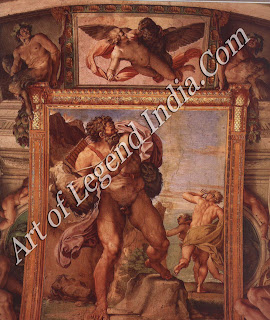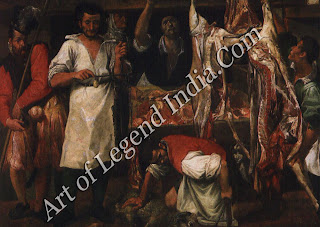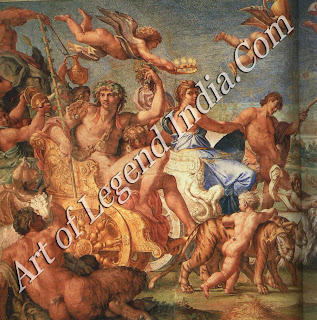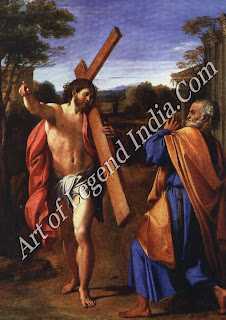 As he Wandered disconsolately
along the sea shore, Polyphemus saw Galtea in the arms of her lover Acis , and
in his rage threw an enormous boulder at the youth and killed him. Polyphemus
is the most magnificent single figure in the
farnese Gallery, his twisting pose brilliantly converying a sense of
enormous physical exertion.
As he Wandered disconsolately
along the sea shore, Polyphemus saw Galtea in the arms of her lover Acis , and
in his rage threw an enormous boulder at the youth and killed him. Polyphemus
is the most magnificent single figure in the
farnese Gallery, his twisting pose brilliantly converying a sense of
enormous physical exertion.The Italian Great Artist – Annibale Carracci Painting Gallery
Posted by
Art Of Legend India [dot] Com
On
1:14 AM
Most of Annibale's paintings
are either religious or mythological works painted in an elevated style, but
early in his career he did some everyday life scenes that are remarkable for
their lively and humorous imagination. The Butcher's Shop and The Bean-Eater
are two of the finest examples. In more traditional subject areas,
Annibaleexcelled both in fresco and as an easel painter. His decoration of the
Farnese Gallery was one of the key works in the development of 17th-century
painting, and individual scenes within the glorious complex stand out as
masterpieces in their own right.
On a more intimate scale, Annibale created
some moving religious works, particularly late in his career. `Domine, Quo
Vadis?' and The Dead Christ Mourned show all the clear and precise handling of
emotional themes, through beautifully controlled gestures and expressions, that
made his work an inspiration to classically-minded painters such as Nicolas
Poussin.
This
Painting was discovered only in 1965, but had previously been known through
engravings.Venus and Adonis was an extremely popular subject, not only with
painters, but also with poets (including, Shakespeare). After being grazed with
one of cupid’s arrows, Venus , the goddess of love, is helplessly smitten with
the beautiful Adonis. Later he is killed while hunting
This is the largest scene in
the Farnese Gallery, dominating the centre of the ceiling. Annibale has created
a balance between firmness of structure, based on his powerful command of
figure drawing, and a lively sense of movement, expressed in the flowing,
undulating rhythms of the composition. The sense of spontaneous high spirits
that the picture convoys belies the painstaking preparatory work that went into
it.
This
and the painting opposite from pair based on the story of the love of the
Cyclops (one – eyed giant) Polyphemus, the son of Neptune, for the nymph
Galatea. In Bellori’s words, he’sits on a promontory in the Sicilian Sea,
Soothing his palpitation by stridently singing to the accompaniment of the
reeds’.
 As he Wandered disconsolately
along the sea shore, Polyphemus saw Galtea in the arms of her lover Acis , and
in his rage threw an enormous boulder at the youth and killed him. Polyphemus
is the most magnificent single figure in the
farnese Gallery, his twisting pose brilliantly converying a sense of
enormous physical exertion.
As he Wandered disconsolately
along the sea shore, Polyphemus saw Galtea in the arms of her lover Acis , and
in his rage threw an enormous boulder at the youth and killed him. Polyphemus
is the most magnificent single figure in the
farnese Gallery, his twisting pose brilliantly converying a sense of
enormous physical exertion.
This fairly uncommon subject is
based on the tradition that St Peter, Fleeing from the persecution of
Christians in Nero’s Rome, saw a vision
of Christ carrying his cross ; in answer to his
question ‘Domine ,Quo vadis? (Lord, where are you going ?), Christ said
he was going to rome to be crucified a second time.
Annibale’s late works are characterized
by their severe classical style, demonstrated in this particular work by the stylized rhetorical gestures,the
carefully orchestrated composition and
the rich, almost strident colouring. This rigorous approach gives the picture
an even greater emotional intensity.
Writer –
Marshall Cavendish
Subscribe to:
Post Comments (Atom)














0 Response to "The Italian Great Artist – Annibale Carracci Painting Gallery "
Post a Comment